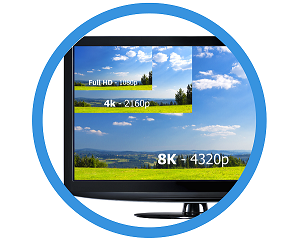Digital TV blends seamlessly into our lives, cleansing the facades of houses from satellite dishes. While terrestrial television switched to a digital signal, streaming services already showed a picture in 4K. Under the cut, we will talk about what is happening with modern TV.

From a simple TV to a smart one
Over the past six years, TV sales have declined. The biggest decline occurred from 2014 to 2015. This may be due to an increase in content on the Internet: the popularity of bloggers is growing, there are new Internet broadcasts, series and subscriptions to movie services. Since 2016, people are again interested in TVs, because the cost of smart TV is reduced, and the number of films in Full HD and 4K is growing.

Buyers still show a steady interest in TVs: someone watches TV on their favorite series, someone uses streaming services, while someone else uses a TV as a background noise generator.

From 2016 to 2019, among all TVs purchased in Russia, the share of smart TVs increased from 38 to 50 percent, that is, users not only watch live television, but also want to choose broadcasting services themselves.

In 2013, there was a peak in sales of 3D TVs. But for such devices, special glasses were needed, which had to be bought additionally. Due to problems with accessories and films with 3D support, which was several times less than the content in the usual format, this technology remained in theaters. High-definition LED TVs have gained popularity in home systems. At the same time, a decrease in the price of 4K TVs had a positive effect on their sales. If in 2015 the share of sales of TVs with UltraHD resolution support was slightly more than 3%, then this year 4K TVs already occupy a quarter of all sales. It is curious that the simplest TVs with HD (720p) resolution have practically not lost their positions. Probably, they just occupy the very niche of the noise field generator in the kitchen or cottage, where high resolution and a large diagonal are not needed.

In parallel with this, almost all film news come out in 4K resolution, which allows you to enjoy the picture and good sound at home. The frame rate at FullHD reached 60, and at 4K resolution already - 120 - 200 frames per second. The dynamic range of the matrices also allows you to demonstrate a more juicy picture, and the smoothness of movement with increasing frame rate only wins.
Digital TV Wifire TV
Providers also offer to connect a TV that you can watch from different devices wherever there is Internet. For example, Wifire TV can easily work both on its own broadband networks, and through any other Internet provider. It is enough to provide the necessary data transfer rate. In this case, the user himself can choose any of three ways to watch digital television:
- TV set-top box
- SmartTV App
- Application on smartphone or tablet
In total, Wifire TV offers 4 basic and 11 additional television packages. In addition, inside Wifire TV, you can watch content from such online cinemas as Megogo, IVI, Start, More.tv and Amediateka in standard resolution and in Full HD. So far, only one channel is presented as 4K, but soon there will be more.
What will happen next
While the market is only mastering the 4K picture, manufacturers have already thought about increasing the resolution and improving the quality of the picture. For example, Japan announced broadcasting from the 2020 Olympic Games as 8K.
Right now, only a few manufacturers offer 8K TVs. Prices range from 250 thousand to 5 million rubles, depending on the diagonal: from 55 to 98 inches. Content in this quality is currently extremely small.
We can safely assume that in the near future television will gradually switch to the Full HD broadcast format. Filmmakers and viewers who will be transplanted to TVs with support for 4K resolution will connect to them.
How do you see television of the future and how often do you use TV at home?